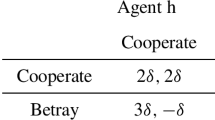Abstract
The stable matching problem is that of matching two sets of agents in such a manner that no two unmatched agents prefer each other to their actual partners under the matching. In this paper, we present a set of sufficient conditions on the preference lists of any given stable matching instance, under which the optimality of the original male optimal stable matching is still preserved.
Similar content being viewed by others
References
D. Gale and L. S. Shapley,College admissions and the stability of marriage, Amer. Math. Monthly 69 (1962), pp. 9–15.
D. Gusfield,Three fast algorithms for four problems in stable marriage, SIAM J. Comput. Vol. 16, No. 1, Feb. 1987, pp. 111–128.
R. W. Irving and P. Leather,The complexity of counting stable marriages, SIAM J. Comput., Vol. 15, 1986, pp. 655–667.
R. W. Irvin, P. Leather and D. Gusfield,An efficient algorithm for the optimal stable marriage, J. ACM, Vol. 34, No. 3, July 1987, pp. 532–543.
D. G. McVitie and L. B. Wilson,The stable marriage problem, Communication of the ACM, Vol. 14, No. 7, July 1971, pp. 486–490.
D. G. McVitie and L. B. Wilson, Algorithm 411, Pts. 1–3.Three procedures for the stable marriage problem, Communication of the ACM, Vol. 14, No. 7, July 1971, pp. 491–492.
S. S. Tseng and R. C. T. Lee,A parallel algorithm to solve the stable marriage problem, BIT 24, 1984, pp. 308–316.
Author information
Authors and Affiliations
Rights and permissions
About this article
Cite this article
Kuo, R.T., Tseng, S.S. On the invariance of male optimal stable matching. BIT 30, 592–598 (1990). https://doi.org/10.1007/BF01933208
Received:
Revised:
Issue Date:
DOI: https://doi.org/10.1007/BF01933208




